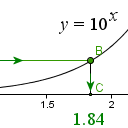IntMath Newsletter: logarithms, arches, body math and habits
By Murray Bourne, 11 May 2010
11 May 2010
In this Newsletter:
1. Math tip: Logarithms - a visual introduction
2. Is the Gateway Arch a parabola?
3. Visual Math
4. IntMath Poll result - Why are you here?
5. Engineering and evolution
6. Recent feedback
7. Final thought – Habits
1. Math tip: Logarithms - a visual introduction
Suitable for: Everyone! All of you will come across logarithms at some stage.
 |
Logarithms are just indices (powers) written down on the line. This article is a visual introduction to logs. At the end of the article I suggest a change to the notation used for logs. There is already a lively discussion going on. Please add your comments there! See more at: |
2. Is the Gateway Arch a parabola?
Suitable for: Everyone. This article has examples of mathematical modelling, parabolas, exponentially increasing and decreasing curves, and catenaries.
 |
The Gateway Arch looks like a parabola on first glance. But is it? See more at: |
3. Visual Math
 |
Nature by numbers Here’s a beautifully done video showing some of the math in nature. Find out more in: |
 |
Math body art Here are some people crazy enough about math to adorn their bodies with it. Find out more in: |
4. Robert Full on engineering and evolution
 |
In this video, Robert Full shows us how nature inspires robot design. We also find out how geckos can walk upside-down on the ceiling. Find out more in: |
5. IntMath Poll result - Why are You Here?
The poll in Apr-May 2010 revealed the following about why visitors come to Interactive Mathematics. Of course, there will be overlapping answers (we may need to "do research" in the process of "doing homework questions").
The question and responses were:
Why are you here?
Studying for an exam
41%
Doing homework questions
27%
General interest
17%
Doing research
15%
Total votes: 2200
A new poll is up and asks readers What's the best time to study Math?
You can respond on any page in IntMath.com.
6. Recent feedback
I love hearing from readers and it is especially gratifying to hear how IntMath has helped people. Here are 2 of the mails I received recently
Gordon Earls, Dublin, Ireland: Very clever. Never seen algebra explained in such a simple and straightforward manner. Keep up the good work.
Anthony, Trinidad and Tobago: I am a student from the University of the West Indies, Trinidad and Tobago.
I didn't understand the way my lecturer taught differential equations, and spent many sleepless nights, reading and browsing youTube videos.
Interactive Mathematics has made it crystal clear, since it has a nice interface, easy to navigate, and the exercises gradually increase in difficulty.
Thanks a lot!!!!!!
You are welcome, Anthony. See more testimonials (there are over 100 of them!).
7. Final thought – Habits
Writer Og Mandino had the following to say about habits. Certainly, success in math depends on the habits we form.
In truth, the only difference between those who have failed and those who have succeeded lies in the difference of their habits. Good habits are the key to all success. Bad habits are the unlocked door to failure. Thus, the first law I will obey, which precedes all others, is — "I will form good habits and become their slaves."
Until next time, enjoy whatever you learn.
See the 3 Comments below.
12 May 2010 at 6:11 pm [Comment permalink]
I am subscribed to many newsletters. The most awaited is the IntMath Newsletter.
Aurangzeb Khan, Pakistan.
12 May 2010 at 9:12 pm [Comment permalink]
I have always loved Fibonacci and the maths involved here. The video on Natue was wonderful and I have passed on this link to many friends (maths teachers and others) who have also commented on it's beauty and mathematics. 🙂
13 May 2010 at 9:51 am [Comment permalink]
Thanks for the feedback, Sue - glad you found it interesting!